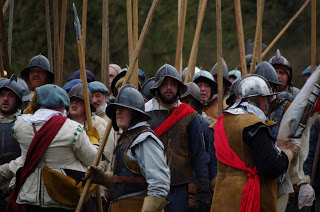Dry Stone Walls
For the none UK readers of this blog, a quick explanation: fields in the UK historically were enclosed by either hedgerows or dry stone walls, and occasionally a hybrid of the two. Depending upon whereabouts in the country you are you will find a dominant method. Here in the Peak District we have dry stone walls as stone is a free resource lying around on the ground, in nearby Cheshire where stone is less easy to come by you find fields divided by hedgerows (also known in mountain rescue circles as God's barbed wire). Many of the dry stone walls in the Peak were built in the seventeenth century, only requiring occasional repairs.
I have a quantity of hedgerows, but fancied some dry stone walls for some variety. Living in the Peak, and knowing a few drystone wallers, any stone walls would need to be correct!
I looked around and found that most of the commercially available models didn't have coping stones on them, so they wouldn't do. I found two models that were accurate representations: one from PP, and one from TSS (Freikorps 15/QRF for us old duffers.)
The PP offering is the better representation but had built in corners; the TSS version consisted of straight sections, corners, gateways, t-sections, collapsed sections and half lengths which suited my needs better, and would work out ridiculously expensive.
I have tried some of the TSS modular buildings before and didn't like them, consigning them to the bin before they were completed. I was hoping for a better experience with the walls. My order arrived promptly, but like the buildings that I had tried, the wall sections needed considerable preparation before they received their base coat.
Regular readers will have noticed that I have been rather quiet of late on the blog, I've been waiting for a dry spell so I could go outside with a power sander to make the wall bases level and flat. A large proportion of the walls delivered required a considerable amount of excess resin removing from their base, a job best tackled with a sander.
If sanding resin wear a face mask and eye protection - resin dust is really nasty stuff. (Yes I know we should wear this stuff whenever we use a power sander, but to be honest most of the time I certainly forget or can't be bothered. Not so with resin.)
Once sanded the walls were washed and I sprayed them with Liquitex raw umber 7. Once dried they got a very heavy wash of Citadel Agrax Earthshade (I got through four bottles of the stuff, but there is a fair bit of walling), followed by a medium/light wash of Nuln Oil.
Despite the hassle of having to do some pretty heavy sanding preparation I am very pleased with how these have come out. I am particularly pleased with the colouring: to me it is pretty accurate for my local walls made from weathered gritstone.
I have a quantity of hedgerows, but fancied some dry stone walls for some variety. Living in the Peak, and knowing a few drystone wallers, any stone walls would need to be correct!
I looked around and found that most of the commercially available models didn't have coping stones on them, so they wouldn't do. I found two models that were accurate representations: one from PP, and one from TSS (Freikorps 15/QRF for us old duffers.)
The PP offering is the better representation but had built in corners; the TSS version consisted of straight sections, corners, gateways, t-sections, collapsed sections and half lengths which suited my needs better, and would work out ridiculously expensive.
I have tried some of the TSS modular buildings before and didn't like them, consigning them to the bin before they were completed. I was hoping for a better experience with the walls. My order arrived promptly, but like the buildings that I had tried, the wall sections needed considerable preparation before they received their base coat.
Regular readers will have noticed that I have been rather quiet of late on the blog, I've been waiting for a dry spell so I could go outside with a power sander to make the wall bases level and flat. A large proportion of the walls delivered required a considerable amount of excess resin removing from their base, a job best tackled with a sander.
If sanding resin wear a face mask and eye protection - resin dust is really nasty stuff. (Yes I know we should wear this stuff whenever we use a power sander, but to be honest most of the time I certainly forget or can't be bothered. Not so with resin.)
Once sanded the walls were washed and I sprayed them with Liquitex raw umber 7. Once dried they got a very heavy wash of Citadel Agrax Earthshade (I got through four bottles of the stuff, but there is a fair bit of walling), followed by a medium/light wash of Nuln Oil.
If you enjoyed reading this, or any of the other posts, please consider supporting the blog.
Thanks.




.jfif)







Comments
Post a Comment